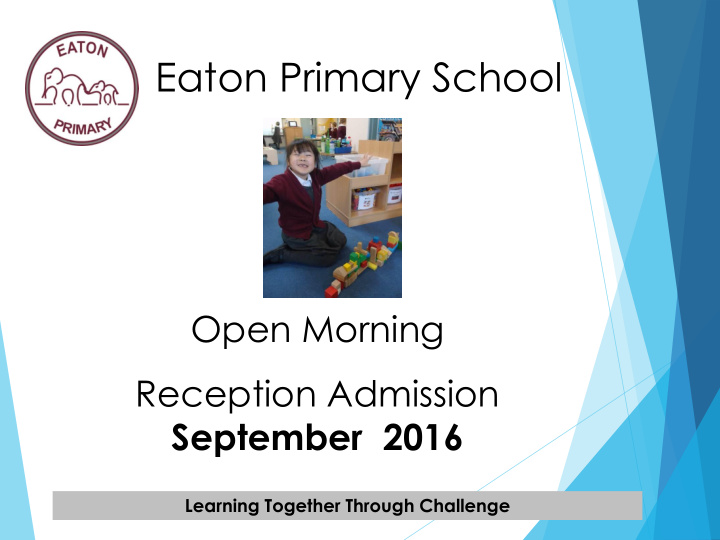



Eaton Primary School Open Morning Reception Admission September 2016 Learning Together Through Challenge
Welcome from Headteacher, Mr Lowe
Vision and Values Our Vision Every child has a happy, safe, and inspiring learning journey. Our Values We strive to achieve our aims through promoting and acting on the values of Trust, Openness, Respect and Integrity.
Aims To provide a safe and stimulating learning environment, through robust financial management and adherence to policy and procedure, in which we all continually strive to provide excellence for our children. To fulfil the potential of every child, through encouragement and challenge, so that they can be adaptable and self-sufficient and are prepared for life ahead. To achieve high levels of motivation and well-being for our employees, through quality training and personal development. To foster trust and confidence from our community partners, so that we can both learn from and contribute to our local, national and global neighbours.
School Leadership Evolution Academy Trust – Board of Directors and CEO Governing Body – Parents and Community partners Senior Leadership Team – Headteacher, Deputy and Assistant Heads
Miss Christina Hughston EYFS Leader & Mrs Lucy Coy Assistant Headteacher
The Early Years Foundation Stage Curriculum (EYFS) Children in the Reception year follow a curriculum called the Early Years Foundation Stage. This framework supports children to become active, motivated and independent learners. The EYFS is a play-based curriculum which covers seven key areas of learning. At Eaton Primary School, these areas are delivered in a cross-curricular, practical way. This allows children to use and apply their learning in a variety of contexts.
Our Topics Reception Topic Plan Marvellous Me! Let’s Celebrate! Seasons, Weather and days of the week are on-going throughout Autumn Term Bears Changes Sprin ing T Term Half Term the year. Let’s Pretend Treasure Summer Term These topics cover the 7 areas of learning: Communication and Language, Personal, Social and Emotional Development, Physical Development, Literacy, Mathematics, Understanding the World and Expressive Arts and Design.
Our Daily Routines Reception school times- 8:40am – 3:15pm Our timetable allows opportunities for direct teaching, group work and independent play. Below is an example of a ‘typical’ day in Reception, although we remain flexible to meet the needs of the children. Morning: 8:40- Early bird activities 8:55- Register 9:00- Read, Write Inc. (our phonics scheme) 9:25- Group work and independent learning time - Snack time, outdoor learning 10:30- Mathematics carpet session 10:45- Group work and independent learning time - outdoor learning, creative activities 11:40- Tidy up time followed by a story 12:00- Lunchtime
Our Daily Routines Afternoon: 12:00- Lunchtime 1:00- End of lunchtime, return to class ready for afternoon learning 1:15- Register followed by topic carpet session 1:30- Group work and independent learning time 2:45- Tidy up time followed by stories, songs and getting ready for hometime 3:15- Hometime
How do we teach phonics, reading and writing in Reception? We use a comprehensive phonics scheme called Read, Write Inc. This is a structured, fast-paced programme that enables all children to quickly learn to read and write. Children take part in a fun, interactive phonics session each day. They learn a new letter sound, practise the correct formation and begin to read and spell words containing the sounds they know. As the primary approach, children are taught to ‘sound - out’ words to read and spell. As they become more confident with this, they extend their reading and writing to include captions and sentences.
How do we teach phonics, reading and writing in Reception? During our independent learning time, children are provided with a wide range of opportunities to apply their new phonic knowledge. For example: Can you practise writing the new letter in the sand tray, on the whiteboard, in shaving foam, on the chalkboard etc? Can you write a label for the animals in the vet role play area? Can you read the words and match them to the pictures?
Building the Foundations of Lifelong Learning
Building the Foundations of Lifelong Learning
Partnership With Parents The two-way communication between home and school is vital in supporting your child’s learning. We aim to involve parents in their child’s learning as often as possible. Here are a few of the ways we do this: Newsletters • Twitter updates • Parent consultations • ‘Welcome Wednesdays’ - a chance for you to • pop into class at the start of the school day and support your child as they enjoy an activity ‘Tapestry’ Online Learning Journal - a new • approach to recording learning. You can log on to view your child’s profile and add your own comments and photographs.
How does Tapestry work at home for parents? Reception staff support and extend children's learning during group work and their own play. To evidence the learning taking place, staff take photographs and make written observations on iPads. These are uploaded to ‘Tapestry’ to create a record of each child’s achievements. Tapestry enables parents to: Log on to view these photographs and written observations at any time. See how this evidence fits with our Early Years assessment criteria. Find out what your child’s ‘next steps’ for learning are. Upload your own photographs/ written comments to share what your child has achieved at home.
Time for a tour of the Reception learning environment! If you have any questions, please come and ask.
Thank you for coming
Recommend
More recommend